Genetic variability studies in F2 segregating populations for yield and its component traits in Okra [Abelmoschu sesculentus (L.)Moench]
Bạn đang xem bản rút gọn của tài liệu. Xem và tải ngay bản đầy đủ của tài liệu tại đây (240.47 KB, 10 trang )
Int.J.Curr.Microbiol.App.Sci (2019) 8(4): 855-864
International Journal of Current Microbiology and Applied Sciences
ISSN: 2319-7706 Volume 8 Number 04 (2019)
Journal homepage:
Original Research Article
/>
Genetic Variability Studies in F2 Segregating Populations for Yield and Its
Component Traits in Okra [Abelmoschu sesculentus (L.)Moench]
V.N. Kavya1*, Prakash Kerure2, V. Srinivasa3, M. Pitchaimuthu4,
Y. Kantharaj5 and B.N. Harish Babu6
1
Department of Vegetable Science, COH, Mudigere, 2ICAR-KVK, Hiriyur, 3Department of
Vegetable Science, COH, Mudigere and 4Division of vegetable crops, ICAR-IIHR, Bengaluru,
5
Department of PHT, COH, Mudigere, 6AICRP on Groundnut, ZAHRS, Hiriyur, India
*Corresponding author
ABSTRACT
Keywords
Genetic variability,
Heritability,
Genetic advance,
Segregating
populations, Biparental crosses
Article Info
Accepted:
07 March 2019
Available Online:
10 April 2019
In the present investigation, an attempt has been made to evaluate genetic variability of
yield and its contributing traits in F2 segregating populations of three bi-parental crosses
viz., IIHR-875 × IIHR-478, IIHR-478 × IIHR-567 and IIHR-604 × IIHR-347 respectively,
along with the parents, F1’s and commercial check (Arka Anamika). For growth and yield
parameters the estimates of phenotypic variance (PV) was higher compared to genotypic
variance (GV) for all the traits in F2 segregating populations of the three bi-parental
crosses. Magnitude of PCV and GCV values was high for number of fruits per plant in
IIHR-875 × IIHR-478, plant height and total yield per plant in the bi-parental cross IIHR478 × IIHR-567, While in the bi-parental cross IIHR-604 × IIHR-347 recorded high PCV
and GCV values were recorded for number of fruits per plant and total yield per plant.
High broad sense heritability values were recorded for the traits plant height and total yield
per plant in the bi-parental crosses IIHR-478 × IIHR-567 and IIHR-604 × IIHR-347
whereas in the bi-parental cross IIHR-875 × IIHR-478 exhibited high broad sense
heritability value for the trait plant height. Thus, there is an ample scope for improving
these traits through direct selection.
vegetable crop of the tropics and subtropics of
the world and has found its place in India
since time immemorial. Okra is significant
herbaceous annual crop, having a somatic
chromosome number of 2n=130 and is
considered to be an amphidiploid. It is being
an often cross pollinated crop, out crossing
occurs to an extent of 4 to 19 per cent with a
maximum of 42.2 per cent by insect assisted
pollination (Kumar, 2006), which render a
Introduction
Okra [Abelmoschus esculentus (L.) Moench]
is a prestigious and prize value vegetable
crop, which has captured a significant
position among vegetables in India. It is
especially valued for its tender green fresh
delicious fruits, which are used as vegetable.
Okra is normally cultivated during summer
and rainy seasons and it is an important
855
Int.J.Curr.Microbiol.App.Sci (2019) 8(4): 855-864
considerable amount of variability. Okra is
being cultivated for its fibrous fruits or pods.
It has multiple virtues, where tender fruits are
used as vegetable, eaten boiled or in culinary
preparations as sliced and fried pieces. It is
also used in thickening of soups and gravies
because of its high mucilage content. Okra
fruits are sliced, sundried, canned and
dehydrated for off-season use. Fruits are rich
source of iodine which is helpful in curing
goiter.
proper selection is not exercised. The present
study was formulated to quantify the extent of
genetic variability available for total yield per
plant and its component traits in F2
segregating populations of okra and to
estimate the genetic gain that can be made by
selection.
Materials and Methods
The experimental material in the present
study consisted of five contrasting parental
lines viz., IIHR-875, IIHR-478, IIHR-567,
IIHR-604 and IIHR-347. Three crosses were
developed by mating the contrasting parent’s
viz., IIHR-875 × IIHR-478 (C-1), IIHR-478 ×
IIHR-567 (C-2) and IIHR-604 × IIHR-347(C3). The F1 progeny of these three bi-parental
crosses was raised to generate F2 populations.
The parents and their respective F1’s and F2
populations were sown without replication.
The parents and hybrids and F2 populations
were evaluated in an unreplicated trail and all
the recommended package of practices was
carried out to grow a successful crop. The
experiment was carried out at ICAR-KVK,
Babbur farm, Hiriyur (Tq), Chitradurga
(Dist.), Karnataka (State) during kharif season
of2017-2018. The observation recorded from
five competitive plants per parent and hybrid
cross. The mean of these five plants was
considered for statistical analysis. With
respect to F2, observations were recorded on
119 plants in C-1, 224 plants in C-2 and 214
plants in C-3 on the 12 characters viz., plant
height (cm), inter-nodal length (cm), branches
per plant (No.), stem girth (mm), first fruit
producing node, fruit length (cm), fruit
diameter (mm) and average fruit weight (g),
number of ridges per fruit, number of locules
per fruit, number of fruits per plant, total yield
per plant (g) as per the NBPGR minimal
descriptors. Genotypic and phenotypic coefficient of variation were calculated
according to the method suggested by Burton
and De-Vane (1953). Heritability in broad
All forms of plant improvement activities
through breeding contemplate an eventual
boost in genetic potential for yield. Since
yield is polygenically controlled and highly
influenced by environment, selection based
on yield alone is not effective. The breeder
while selecting for high yield has to select
indirectly through yield associated and highly
heritable
characters
after
eliminating
environmental components of phenotypic
variance. An attempt to improve a character
by selection would be futile unless a major
portion of variation is of genotypic and
quantitative assessment of the population for
yield and its contributing characters is
necessary. Study of different variability
parameter provides a strong basis for
selection of desirable genotype for
augmentation of yield and other agronomical
attributes. Such study estimates the feasibility
of using available genetic resources for
effective improvement. The F2 generation is
critical for success of the breeding
programme, as there are remote chances of
recovering superior recombinants in advanced
generations.
To achieve genetic improvement in yield
traits, it is imperative to generate information
on variability, its heritable proportion and also
interrelationships existing in the breeding
material the breeding programme, as there are
remote chances of recovering superior
recombinants in advanced generations, if
856
Int.J.Curr.Microbiol.App.Sci (2019) 8(4): 855-864
sense and the genetic advance as percent of
mean to visualize the relative utility of genetic
gain were worked out as suggested by
Johnson et al., (1955).
Padda (1963), Kadlera (1997) and Akinyele
and Osekita (2008).
The results on the variability, heritability and
genetic advance for 12 characters in okra have
been presented in Table 1. For all the
characters, the values of phenotypic
coefficient of variation (PCV) were higher
than the genotypic coefficient of variation
(GCV).
Results and Discussion
In okra, the mean values were worked out for
12 quantitative characters in F2 segregating
populations of the three bi-parental crosses
and expressed in Table 1.
Plant height (cm)
The F2 segregating populations of the biparental cross IIHR-875 × IIHR-478 had
exhibited higher mean value for fruit yield
than other bi-parental crosses. Similarly an
increase in the mean values in the bi-parental
crossIIHR-875 × IIHR-478 was also noticed
for the traits number of branches per plant
(3.64), fruit length (12.82), fruit diameter
(12.80), average fruit weight (14.78), number
of ridges per fruit (5.02), number of locules
per fruit (5.02), number of fruits per plant
(18.72) and it has recorded lower mean values
for plant height (108.72), inter-nodal length
(10.90), stem girth (15.90) and first fruit
producing node (4.65). These results were
close proximity with the findings of Akinyele
and Osekita (2008) and Nwangburuka et al.,
(2012). Thus, based on mean values it is
possible to identify and select the superior
segregants for utilization in breeding
programme to develop good inbred lines.
High PCV (22.13, 24.24 and 23.09) values
were recorded by the three bi-parental cross
derivatives. Bi-parental cross IIHR-478 ×
IIHR-567 showed high GCV (23.32) values
whereas, other two bi-parental crosses
recorded moderate GCV (19.24 and 21.20)
values for plant height were reported by
Nwangburuka
et
al.,
(2012)
and
Shivaramegowda et al., (2016). High GCV
values indicated greater extent of variability
present in the character and can be improved
through selection. All the bi-parental crosses
recorded high broad sense heritability (75.57,
91.30 and 84.33), high GA (37.67, 58.99 and
48.30) and high GAM (34.65, 45.59 and
39.95) for the trait plant height indicates that
the character is governed by additive gene
effects and selection may be effective in such
cases. These results are in proximity with the
earlier findings of Adiger et al., (2011),
Nwangburuka et al., (2012), Prakash and
Pitchaimuthu (2010) and Prakash et al.,
(2017).
For growth and yield parameters the estimates
of phenotypic variance (PV) was higher
compared to genotypic variance (GV) for all
the traits, indicating the role of environmental
factors for the expression of these traits in F2
segregating populations of the three biparental crosses. The PCV values were higher
than the GCV values for growth and yield
related traits in all the three bi-parental
crosses. Similar trends were obtained by
Rangaiah et al., (1999), Vaid and Singh
(1983), Mehta and Zaveri (1999), Kalia and
Inter-nodal length (cm)
Moderate PCV (16.48, 15.80 and 12.22)
values were recorded by all the three biparental cross derivatives. Bi-parental cross
IIHR-478 × IIHR-567 showed moderate GCV
(11.01) values whereas, other two bi-parental
crosses recorded low GCV (8.70 and 8.66)
values for inter-nodal length were reported by
857
Int.J.Curr.Microbiol.App.Sci (2019) 8(4): 855-864
Gandhi et al., (2001) and Saleem et al.,
(2018). Three bi-parental crosses exhibited
low GA (1.03, 1.76 and 1.46). The bi-parental
cross IIHR-875 × IIHR-478 had shown low
heritability coupled with low GAM (9.47) but
other two bi-parental crosses exhibited
moderate
heritability
with
moderate
GAM(15.94 and 12.54) values were reported
by Gandhi et al., (2001).
Bi-parental cross IIHR-478 × IIHR-567 had
moderate heritability (43.34) for the trait stem
girth whereas, other two bi-parental cross had
low heritability (22.84 and 24.52) values for
this trait. All the three bi-parental crosses had
low GA(1.66, 2.93 and 1.50) values for this
character. Low GAM (9.62) exhibited
byIIHR-604 × IIHR-347 and other two biparental crosses had moderate GAM (10.43
and 17.48) values.
Number of branches per plant
First fruit producing node
Moderate PCV (16.93, 16.95 and 16.80)
values were exhibited by all the three biparental cross derivatives. Bi-parental
crossIIHR-478 × IIHR-567 showed low GCV
(8.72) values whereas, other two bi-parental
crosses recorded moderate GCV (11.65 and
10.54) values for number of branches per
plant have been reported by Guddadamath et
al., (2010), Koundinya et al., (2013), Prakash
et al., (2017) and Sravanthi (2017).
Low PCV(9.04) recorded by the bi-parental
cross IIHR-478 × IIHR-567 whereas, other
two bi-parental crosses shown moderate PCV
(14.93 and 13.90) value for this character. Biparental cross IIHR-604 × IIHR-347 had
exhibited moderate GCV (10.21) values and
other two bi-parental crosses recorded low
GCV (6.16 and 6.49) values indicates the lack
of variability in the tested breeding material.
The bi-parental cross IIHR-478 × IIHR-567
recorded low heritability coupled with low
GAM values (26.47 and 9.03) but other two
bi-parental crosses exhibited moderate
heritability (47.37 and 39.39) coupled with
moderate GAM (16.23 and 13.39) values
indicates that character is governed by nonadditive gene action and hybridization
followed by selection would be useful for
improving this character. Three bi-parental
crosses had low GA values for this character.
Low estimates of heritability (17.01) had
recorded by the bi-parental cross IIHR-875 ×
IIHR-478 but other two bi-parental crosses
exhibited moderate heritability (51.46 and
53.92) values. Three bi-parental crosses had
low GA (0.24, 0.47 and 0.72) values for this
character. Bi-parental cross IIHR-604 × IIHR347 had shown moderate GAM (15.52) and
other two bi-parental crosses had exhibited
low GAM (9.62 and 5.20)
Fruit length (cm)
Stem girth (mm)
Moderate PCV (17.41, 16.57 and 16.60)
values were exhibited by all the three biparental cross derivatives were reported by
Adeoluwa and Kehinde (2011), Adiger et al.,
(2011), Gangashetti et al., (2013), Prakash et
al., (2017) and Saleem et al., (2018). Biparental cross IIHR-478 × IIHR-567 had
shown low GCV (9.62) values but other two
bi-parental crosses exhibited moderate GCV
(12.56 and 10.25) values for this character.
Bi-parental cross IIHR-875 × IIHR478showed high PCV (22.06) values whereas,
other two bi-parental crosses exhibited
moderate PCV (19.80 and 18.74) values. Low
GCV (9.28) values recorded by the biparental cross IIHR-604 × IIHR-347 and
other two bi-parental crosses had moderate
GCV (10.54 and 13.04) values.
858
Int.J.Curr.Microbiol.App.Sci (2019) 8(4): 855-864
Table.1 Estimates of genetic parameters for growth and yield attributes in F2 segregating generations of the three bi-parental Crosses
in Okra (IIHR-875 X IIHR-478, IIHR-478 X IIHR-567, IIHR-604 X IIHR-347)
Sl.
No.
Characters
1
Plant height (cm)
2
Inter nodal length (cm)
3
No. of branches per plant
4
Stem girth (mm)
5
First fruit producing node
6
Fruit length (cm)
7
Fruit diameter (mm)
8
Average fruit weight (g)
9
No. of ridges per fruit
Biparental
crosses
Cross 1
Cross 2
Cross 3
Cross 1
Cross 2
Cross 3
Cross 1
Cross 2
Cross 3
Cross 1
Cross 2
Cross 3
Cross 1
Cross 2
Cross 3
Cross 1
Cross 2
Cross 3
Cross 1
Cross 2
Cross 3
Cross 1
Cross 2
Cross 3
Cross 1
Mean
Range
Min.
Max.
108.72
129.4
120.9
10.90
11.02
11.66
3.64
3.44
3.42
15.90
16.77
15.63
4.65
5.02
4.74
12.82
12.79
12.11
12.80
12.41
12.27
14.78
14.38
13.72
5.02
65.50
61.20
70.10
7.20
6.60
9.10
3.00
2.00
3.00
10.08
9.64
10.01
3.00
4.00
3.00
10.10
10.00
10.00
10.03
10.01
10.10
10.30
10.03
10.30
5.00
175.60
199.20
198.20
15.90
17.60
17.20
5.00
5.00
5.00
28.60
26.75
24.28
6.00
7.00
6.00
19.60
19.60
22.10
19.82
20.77
22.00
27.72
26.02
25.67
7.00
859
GV
PV
GCV
(%)
PCV
(%)
h2
(%)
GA
GAM
(%)
437.65
904.27
657.13
0.90
1.47
1.02
0.18
0.09
0.13
2.81
4.78
2.10
0.08
0.11
0.23
2.59
1.51
1.54
2.88
2.24
2.08
4.91
4.90
1.73
0.32
579.14
990.41
779.28
3.23
3.03
2.03
0.38
0.34
0.33
12.30
11.03
8.58
0.48
0.21
0.43
4.98
4.49
4.04
5.50
4.17
3.34
13.36
9.77
7.60
0.42
19.24
23.24
21.20
8.70
11.01
8.66
11.65
8.72
10.54
10.54
13.04
9.28
6.16
6.49
10.21
12.56
9.62
10.25
13.25
12.05
11.76
14.98
15.39
9.58
11.27
22.13
24.32
23.09
16.48
15.80
12.22
16.93
16.95
16.80
22.06
19.80
18.74
14.93
9.04
13.90
17.41
16.57
16.60
18.32
16.45
14.89
24.73
21.74
20.09
12.91
75.57
91.30
84.33
27.90
48.55
50.22
47.37
26.47
39.39
22.84
43.34
24.52
17.01
51.46
53.92
52.09
33.69
38.12
52.29
53.70
62.39
36.72
50.10
22.72
76.19
37.67
58.99
48.30
1.03
1.76
1.46
0.59
0.31
0.46
1.66
2.93
1.50
0.24
0.47
0.72
2.39
1.48
1.57
2.51
0.04
2.35
2.78
3.21
1.30
0.31
34.65
45.59
39.95
9.47
15.94
12.54
16.23
9.03
13.39
10.43
17.48
9.62
5.20
9.42
15.25
18.63
11.55
12.99
19.58
0.36
19.15
18.82
22.35
9.50
6.24
Int.J.Curr.Microbiol.App.Sci (2019) 8(4): 855-864
10
No. of locules per fruit
11
No. of fruits per plant
12
Total yield per plant (g)
Cross 2
Cross 3
Cross 1
Cross 2
Cross 3
Cross 1
Cross 2
Cross 3
Cross 1
Cross 2
Cross 3
5.01
5.01
5.02
5.01
5.01
18.72
17.84
16.66
315.03
279.68
251.22
5.00
5.00
5.00
5.00
5.00
10.00
10.00
10.00
107.60
120.96
110.33
6.00
6.00
7.00
6.00
6.00
46.00
41.00
44.00
1274.97
1066.91
998.36
0.20
0.04
0.27
0.10
0.04
26.08
7.61
17.32
238.83
20078.25
15880.55
GV: Genotypic variance, PV: Phenotypic variance, GCV: Genotypic coefficient of variance,
PCV: Phenotypic coefficient of variance, h2 (b): Heritability (Broad sense), GA: Genetic advance,
GAM: Genetic advance as per cent mean
Cross 1-IIHR-875 X IIHR-478 , Cross 2- IIHR-478 X IIHR-567, Cross 3-IIHR-604 X IIHR-347
860
0.30
0.14
0.42
0.20
0.14
48.78
32.71
31.71
445.10
25170.00
22601.12
8.93
3.99
10.35
6.31
3.99
27.28
15.46
24.98
4.91
50.66
50.10
10.93
7.47
12.91
8.93
7.47
37.31
32.06
33.80
6.70
56.73
59.76
66.67
28.57
64.29
50.00
28.57
53.46
23.26
54.63
53.66
79.77
70.26
0.13
0.07
0.26
0.09
0.07
7.62
2.71
6.38
234.67
261.46
216.78
2.59
1.31
5.25
1.85
1.31
40.71
15.16
38.29
74.49
93.48
86.18
Int.J.Curr.Microbiol.App.Sci (2019) 8(4): 855-864
The three bi-parental crosses recorded
moderate heritability (52.09, 33.69 and
38.12), low GA (2.39, 1.48 and 1.57) and
moderate GAM (18.63, 11.55 and 12.99) for
the trait fruit length have been reported by
Bagwale et al., (2016).
Number of ridges per fruit
The bi-parental cross IIHR-604 × IIHR-347
had recorded low PCV (7.47) values and
other two bi-parental crosses recorded
moderate PCV (12.91 and 10.93) values for
this character. Moderate GCV (11.27) values
exhibited by the bi-parental cross IIHR-875 ×
IIHR-478 but other two bi-parental crosses
manifested low GCV (8.93 and 3.99) values
were reported by Prakash et al., (2017) and
Sravanthi (2017). Thebi-parental cross IIHR604 × IIHR-347 had low heritability (28.57)
and other bi-parental crosses shown high
broad sense heritability (76.19 and 66.67)
values. Three bi-parental crosses exhibited
low GA (0.31, 0.13 and 0.007) and GAM
(6.24, 2.59 and 1.31) values for this character.
High heritability with low GAM reveals non
additive gene action and selection for such
traits may not be rewarding. The findings are
in agreement with the results of Sharma et al.,
(2016).
Fruit diameter (mm)
Moderate PCV (18.32, 16.45 and 14.89) and
GCV (13.25, 12.05 and 11.76) were recorded
by the three bi-parental crosses indicates the
role of environment on this character. Similar
findings were reported by Guddadamath et
al., (2011), Prakash and Pitchaimuthu (2010)
and Chandramouli et al., (2016). High broad
sense heritability (62.39) exhibited by the biparental cross IIHR-604 × IIHR-347 and
other two bi-parental crosses had recorded
moderate heritability (52.29 and 53.70) values
for this character. Three bi-parental crosses
recorded low GAM (2.51, 0.04 and 2.35)
values for this character. Bi-parental cross
IIHR-478 × IIHR-567 had shown low GAM
(0.361) but other two bi-parental crosses had
recorded moderate GAM (19.58 and 19.15)
values for fruit diameter were reported by
Kandaswamy (2015).
Number of locules per fruit
Among the bi-parental crosses, the bi-parental
cross IIHR-875 × IIHR-478 had exhibited
moderate PCV (12.91) and GCV (10.35)
along with high heritability (64.29) coupled
with low GA (0.26) and GAM (5.25) values
for this character. Low PCV (8.93) and GCV
(6.31) along with moderate heritability
(50.00) coupled with low GA (0.09) and
GAM (1.85) was recorded by the bi-parental
cross IIHR-478 × IIHR-567. The bi-parental
crossIIHR-604 × IIHR-347 had shown low
PCV (7.47) and GCV (3.99) along with low
heritability (28.57) coupled with low
GA(0.07) and GAM (1.31) values for the
character number of locules per fruit.
Average fruit weight (g)
High PCV (24.73, 21.74 and 20.09) values
were recorded by the three bi-parental cross
derivatives. Bi-parental cross IIHR-604 ×
IIHR-347 had shown low GCV (9.58) but
other two bi-parental crosses exhibited
moderate GCV (14.98 and 15.39) values for
average fruit weight were reported by Hazra
and Basu (2000). The bi-parental cross IIHR604 × IIHR-347 had manifested low
heritability (22.72) coupled with low GA
(1.30) and low GAM (9.50) for this character.
Moderate heritability (36.72 and 50.10)
coupled with low GA (2.78 and 3.21) and
moderate GAM (18.82 and 22.35) was
recorded by the other two bi-parental crosses
were reported by Guddadamath et al., (2010).
Number of fruits per plant
All the bi-parental crosses recorded high PCV
(37.31, 32.06 and 33.80) values and the biparental cross IIHR-478 × IIHR-567 had
861
Int.J.Curr.Microbiol.App.Sci (2019) 8(4): 855-864
exhibited moderate GCV (15.46) whereas,
other two bi-parental crosses manifested high
GCV (27.28 and 24.98) values.The difference
between PCV and GCV was found to be
narrow indicating lesser influence of
environment on these characters and presence
of more variation in the populations to select
superior segregants in the advanced
generation. The results obtained on yield and
yield related characters in the present study
are in agreement with the reports of Yonas et
al., (2014), Kandaswamy (2015), Sravanti
(2017) and Prakash et al., (2017). Bi–parental
cross IIHR-478 × IIHR-567 had shown low
heritability (23.26) coupled with low GA
(2.71) and moderate GAM (15.16) and other
two bi-parental crosses exhibited moderate
heritability(53.46 and 54.63) coupled with
low GA (7.62, 2.71 and 6.38) and high GAM
(40.71 and 38.29)values.
related traits in all the three bi-parental
crosses. In the F2 population of the bi-parental
cross IIHR-875 × IIHR-478 recorded
moderate to high PCV and GCV for all the
characters except for days to 50 per cent
flowering. Whereas F2 population of the biparental cross IIHR-478 × IIHR-567 and
IIHR-604× IIHR-347 exhibited moderate to
high PCV and GCV for all the characters
except for days to 50 per cent flowering,
number of ridges per fruit and number of
locules per fruit. High heritability coupled
with high genetic advance as per cent of mean
was observed for plant height, number of
fruits per plant and total yield per plant in the
F2 population of the bi-parental cross IIHR875 × IIHR-478. Whereas F2 population of
the bi-parental cross IIHR-478 × IIHR-567
exhibited high heritability with high genetic
advance as per cent of mean for plant height
and for total yield per plant. With regard to F2
population of the bi-parental cross IIHR-604
× IIHR-347 high heritability with high genetic
advance as per cent of mean was exhibited for
plant height and total yield per plant. Thus,
there is an ample scope for improving these
traits through direct selection.
Total yield per plant
The bi-parental cross IIHR-875 × IIHR-478
had shown low PCV(6.70 and 4.91) and GCV
values and other bi-parental cross exhibited
high PCV (56.73 and 59.76) and GCV (50.66
and 50.10) values for this character. Biparental cross IIHR-875 × IIHR-478 had
recorded moderate heritability (53.66) and
other two crosses had shown high heritability
(79.77 and 70.26). All the bi-parental crosses
had shown high GA (234.67, 261.46 and
216.78) and high GAM (74.49, 93.48 and
86.18) values for the character.
References
Ade-Oluwa, O. O. and Kehinde, O. B., 2011,
Genetic variability studies in West
African okra (Abelmoschus caillei).
Agric. Biol. J. North America, 2(10):
1326-1335.
Adiger, S., Shanthkumar, G., Gangashetty, P.
I. and Salimath, P. M., 2011,
Association
studies
in
okra
(Abelmoschus esculentus (L.) Moench).
Elect. J. Pl. Breed., 2(4): 568-573.
Akinyele, B. S. and Osekita, O. S., 2008,
Correlation and path analysis of seed
yield attributes in okra [Abelmoschus
esculentus (L.) Moench]. Afr. J.
Biotechnol., 5(14): 1330-1336.
Bagwale, S. B., Jawale, L. N., Deosarkar,
D.B. and Jadhav, R. A., 2016, Genetic
This indicates additive gene effects, and
suggests
that
effective
progress
in
improvement through selection could be
achieved for yield. Similar results were
obtained by Prakash and Pitchaimuthu (2010),
Guddadamath et al, (2010) Adiger et al.,
(2011), Gangashetti et al., (2013) and Prakash
et al., (2017).
In conclusion, the PCV values were higher
than the GCV values for growth and yield
862
Int.J.Curr.Microbiol.App.Sci (2019) 8(4): 855-864
variability studies for yield, yield
contributing and quality traits in okra
[Abelmoschus esculentus (L.) Moench].
Indian J. Agric. Res., 50(6): 614-618.
Burton, G. W. and Devane, R. W., 1953,
Estimating heritability in tall foscue
(Festuca arubdinaces) from replicated
clonal material. Agron. J., 45: 478-481.
Chandramouli, B., Shrihari, D., Rao, A. V. D.
D. andRao, P. M., 2016, Studies on
genetic variability, heritability and
genetic advance in okra [Abelmoschus
esculentus(L.) Monech] genotypes. Pl.
Archives, 16(2): 679-682.
Gandhi, H. T., Yadav, M. D. and Navale, P.
A., 2001, Studies on variability in okra
(Abelmoschus esculentus (L.) Moench).
J. Maharashtra Agric. Univ., 26(2):
146-148.
Gangashetti, P. I., Laxman, M. and Adiger,
S., 2013, Breeding investigations in
single and double cross F4 and F5
populations of bhendi (Abelmoschus
esculentus (L.) Moench). Molecul.Pl.
Breed., 4(12): 96–106.
Guddadamath, S., Mohankumar, H. D.,
Praveenkumar, B. and Sujatha, K.,
2010, Genetic analysis of biparental
mating and selfing in segregating
populations of Bhendi (Abelmoschus
esculentus (L.) Moench). Elect. J. Pl.
Breed., 1(6): 1500-1503.
Hazra, P. and Basu, D., 2000, Genetic
variability, correlation and path analysis
in okra. Ann. Agric. Res., 21(3): 452453.
Johnson, H. W., Robinson, H. F. and
Comstock, R. E., 1955, Estimates of
genetics and environmental variability
in soybeans. Agron.J.,47: 314-318.
Kadlera, D., 1997, Genetic analysis of
biparental and selfing progenies for
seed yield, oil and other quantitative
traits in safflower (Carthamus tinctorius
L.). M. Sc. (Agri.) Thesis, Univ. Agril.
Sci., Dharwad.
Kalia, A. and Padda., 1963, Studies on
biparental progenies in garden pea
(Pisum sativum L.). Indian J. Genet. Pl.
Breed., 63(1): 79-80.
Kandasamy, R., 2015, Variability studies in
okra (Abelmoschus esculentusL.). Asian
J. Hort., 10(1): 60-63
Koundinya, A. V. V., Dhankhar, S. K. and
Yadav, A. C., 2013, Genetic variability
and divergence in okra (Abelmoschus
esculentus). Indian J. Agric. Sci., 83(6):
685.
KUMAR, N., 2006, Breeding of Horticultural
Crops. New India Publishing Agency,
New Delhi, pp. 173-177.
Mehta, D. R. And Zaveri, P. P., 1999, Genetic
variability and association analysis in F5
generation resulted from 3 selection
scheme in cowpea. J. Maharashtra
Agric. Uni., 23: 238-240.
Nwangburuka, C. C., Denton, O. A., Kehinde,
Ojo, D. K. and Popoola, A. R., 2012,
Genetic variability and heritability in
cultivated
okra
[Abelmoschus
esculentus(L.) Moench]. Spanish J.
Agric. Res., 10(1): 123-129.
Prakash, K. and Pitchaimuthu, M. and
Akshata, H., 2017, Studies on
variability, correlation and path analysis
of traits contributing to fruit yield and
its components in okra (Abelmoschus
esculentus (L.) Moench). Elect. J. Pl.
Breed., 8(1): 134-141.
Prakash, K. and Pitchaimuthu, M., 2010,
Nature and magnitude of genetic
variability and diversity studies in okra
(Abelmoschus esculentus (L.) Moench).
Elect. J. Pl. Breed., 1(6):1426-1430.
Rangaiah, S. and Nehru, S. D., 1999, Genetic
variability, correlation and path analysis
in cowpea. Karnataka J. Agric. Sci., 11:
927-932.
Saleem, A. M., Amjad, M., Ziaf, K. and Sahi,
S. T., 2018, Characterization of okra
(Abelmoschus esculentus) genotypes for
fruit firmness, other horticultural traits
863
Int.J.Curr.Microbiol.App.Sci (2019) 8(4): 855-864
and heritability studies. Int. J. Agric.
Biol., 20: 345-352.
Sharma, K. P., Mishra, D. P. and Amitpandey,
2016, Genetic variability studies for
yield and its contributing traits in okra
[Abelmoschus esculentus (L.) Moench].
J. Appl. Nat. Sci., 8(3): 1634–1637.
Shivaramegowda, K. D., Krishnan, A.,
Jayaramu, Y. K., Kumar, V., Yashoda.
andKoh, H., 2016, Genotypic Variation
among Okra (Abelmoschus esculentus
(L.) Moench) Germplasms in South
India. Pl. Breed. Biotechnol., 4(2): 234241.
Sravanthi, U., 2017, Studies on variability,
heritability and genetic advance in okra
[Abelmoschus esculentus (L.) Moench].
Int. J. Curr. Microbiol. Appl. Sci.,
6(10): 1834-1838.
Vaid, I. K. and Singh, K. B., 1993, Genetic
variability in F3 and F4 populations of a
cross in cowpea. Madras Agric. J.,
70:281-283.
Yonas, M., Garedew, W. and Debela, A.,
2014, Variability and association of
quantitative characters among okra
(Abelmoschus esculentus (L.) Moench)
collection in South Western Ethiopia. J.
Bio. Sci., 14(5): 336 – 342.
How to cite this article:
Kavya, V.N., Prakash Kerure, V. Srinivasa, M. Pitchaimuthu, Y. Kantharaj and Harish Babu,
B.N. 2019. Genetic Variability Studies in F2 Segregating Populations for Yield and Its
Component
Traits
in
Okra
[Abelmoschu
sesculentus
(L.)Moench].
Int.J.Curr.Microbiol.App.Sci. 8(04): 855-864. doi: />
864
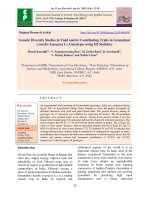
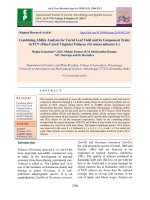
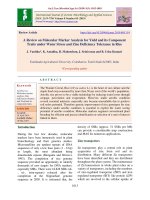

![Genetic variability studies in F2 segregating populations for yield and its component traits in Okra [Abelmoschu sesculentus (L.)Moench]](https://media.store123doc.com/images/document/2020_01/13/medium_nxs1578931693.jpg)
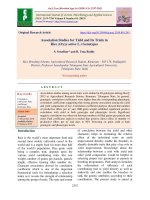

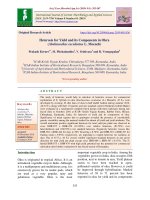
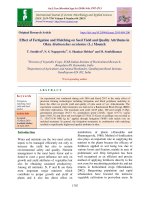
![Correlation and path coefficient analysis of fruits yield and yield attributes in okra [Abelmoschus esculentus (L.) Moench]](https://media.store123doc.com/images/document/2020_01/14/medium_ckb1578982226.jpg)